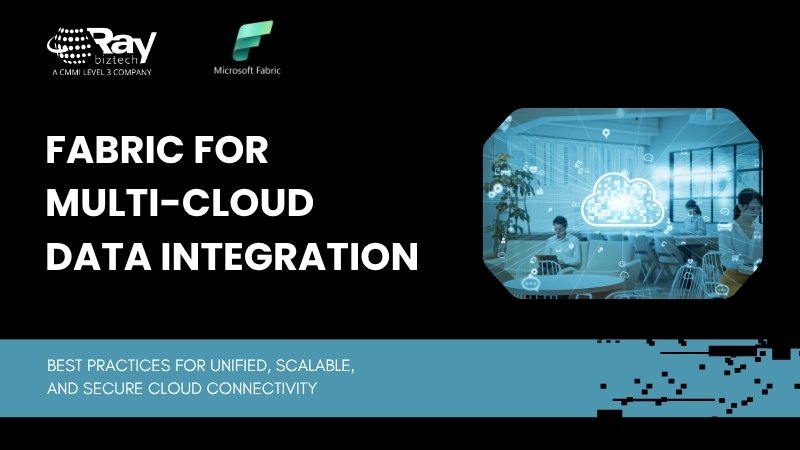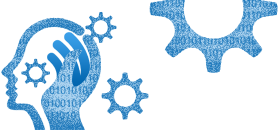Fabric for Multi-Cloud Data Integration – Best Practices

The Challenge Behind Multi-Cloud Freedom
Most enterprises today don’t live in one cloud.
Sales runs in Azure, development builds on AWS and research uses Google Cloud.
Freedom brings flexibility but it also brings fragmentation.
Each environment stores data differently, secures it differently and bills it differently.
Before long, teams realize they’re managing clouds instead of managing insights.
That’s the moment Microsoft Fabric becomes essential.
It acts as the connective tissue that brings structure to multi-cloud complexity.
At Ray Business Technologies, we’ve watched companies recover weeks of lost time simply by letting Fabric coordinate what was once chaos.
OneLake: A Common Ground for Every Cloud
Fabric’s OneLake is built for exactly this problem.
Instead of replicating data between clouds, it creates a single view that spans them all.
Whether your workloads sit in Azure, AWS or GCP, Fabric lets users query data without moving it.
The finance dashboard in Power BI, the sales insights from Dynamics 365 and predictive models in Azure AI all pull from the same governed source.
When our Fabric consulting and architecture teams deploy OneLake, we focus on simplification fewer copies, consistent rules and a single version of truth.
It’s integration without heavy lifting.
Governance: The Quiet Enabler
Security and governance used to slow everything down.
Fabric flips that perception.
With Microsoft Purview built in, policies, access control and lineage flow across connected clouds automatically.
An analyst working on AWS follows the same rules as a data scientist on Azure.
Encryption and compliance don’t break when data crosses boundaries.
At Ray Business Technologies, our Fabric SAP integration and Fabric Oracle integration projects extend that discipline into ERP systems, giving leadership a unified governance framework instead of a patchwork of policies.
Automation Through Fabric Copilot
Every multi-cloud strategy eventually hits an operational ceiling too many manual pipelines, too many monitoring scripts.
Fabric Copilot integration removes that friction.
Teams can describe a workflow in natural language “Connect AWS S3 to Azure Synapse and refresh analytics each Monday.”
Fabric builds and schedules it automatically.
This kind of AI-assisted orchestration has helped RBT clients cut integration effort by nearly half.
Automation doesn’t just save time; it gives consistency, something no script can guarantee long-term.
Designing for Cost Awareness
The cost of multi-cloud isn’t only storage or compute it’s duplication.
Running identical workloads across clouds drains budgets fast.
Fabric’s consumption-based licensing lets enterprises scale resources only when needed.
Our Fabric migration specialists help clients analyze patterns, consolidate redundant services and align Fabric licensing with usage trends.
It’s a disciplined approach to performance spend where it matters, automate the rest.
Lessons from the Field
A global logistics company spread data across AWS warehouses and Azure analytics.
After adopting Microsoft Fabric, they consolidated reporting through OneLake, cutting delivery analytics time from hours to minutes.
Another enterprise in Sydney connected its AI models from Azure to retail data hosted on AWS using Fabric Copilot. That single connection reduced operational overhead by 30 % while improving decision accuracy.
These transformations share one theme integration breeds efficiency.
Ray Business Technologies: Guiding the Multi-Cloud Journey
As a Top Microsoft Fabric Partner in the USA and Australia, we help organizations bridge multi-cloud gaps through:
- Fabric consulting to assess readiness and ROI.
- Fabric architecture design focused on scalability and compliance.
- Fabric implementation and migration services for smooth adoption.
- Fabric Copilot integration for intelligent automation.
- Ongoing MS Fabric training for teams across engineering and analytics.
Our approach blends enterprise experience with innovation ensuring Fabric works for your environment, not the other way around.
Conclusion
Multi-cloud isn’t a passing phase; it’s the shape of modern IT.
What separates leaders from laggards is how seamlessly their systems communicate.
Microsoft Fabric offers that bridge a single fabric of connectivity across every cloud, every dataset and every decision.
At Ray Business Technologies, we believe integration isn’t just about moving data.
It’s about giving people the confidence to act on it securely, intelligently and globally.

